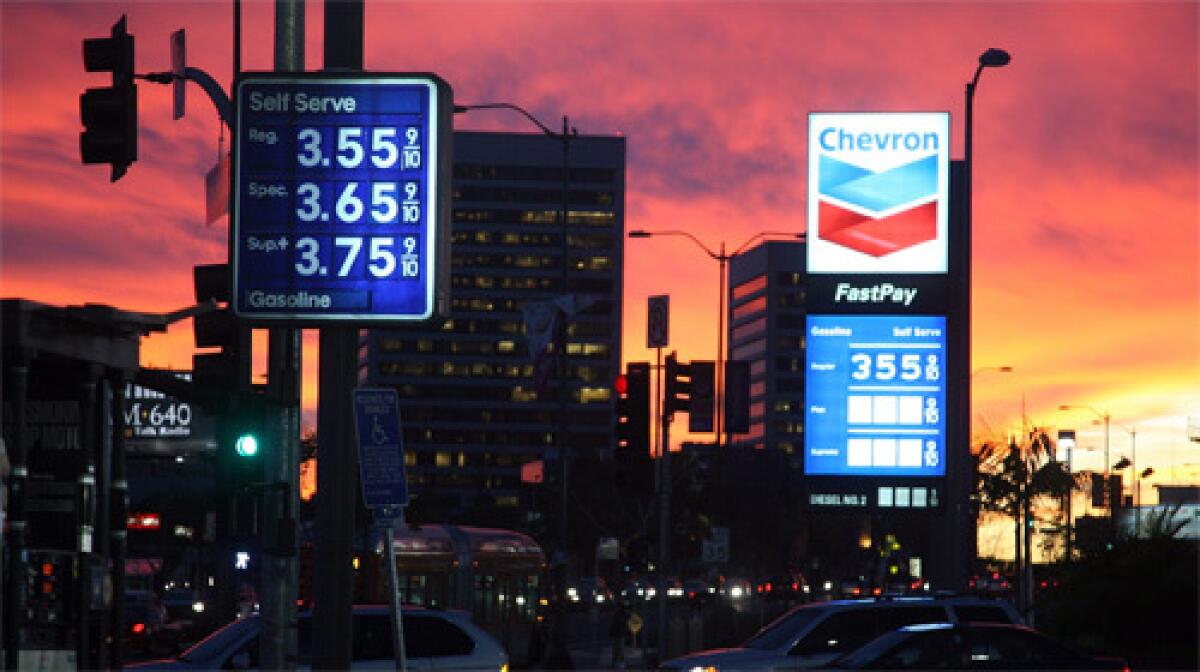High fuel prices are puzzling

The middlemen who buy and sell fuel on the wholesale market have seen Los Angeles gasoline prices plunge more than 50 cents in the last two weeks.
Too bad drivers aren’t seeing the full benefit at the pump.
On Friday, the most recent trading day, the wholesale gasoline price in Los Angeles hovered around $2.17 a gallon -- a figure roughly equal to a retail price of $2.77 a gallon after taxes and other costs were included.
But on Monday, service stations in the city were selling self-serve regular for an average of $3.221 a gallon. Consumer advocates and others smell a rip-off. As proof, they note that a few California refiners have reacted by cutting production, shutting down early for maintenance and lining up exports in an effort to shore up wholesale prices.
“The California economy has been penalized by high gas prices for months, and now, when the opportunity comes for a brief window of significantly lower prices, the workings of the market are being frustrated,” energy economist Philip K. Verleger Jr. said. “The people who own refineries are doing everything they can to prevent [the declining wholesale price] from trickling down to the consumer.”
Erika Zamora, a teacher at Breed Street Elementary School in Boyle Heights, is among the legions of drivers who yearn for a price break.
“It would be nice if we could get under $3,” Zamora said as she paid $3.179 a gallon at a Boyle Heights Shell station Friday. Her commute from Chatsworth has gotten so expensive, she said, that “all I asked for for Christmas was gas cards.”
A smattering of Los Angeles-area gas stations have begun to lead the way downward, with sub-$3 prices popping up Monday at Arco and no-brand stations in Bell Gardens, Downey and Santa Fe Springs, according to GasBuddy.com, an Internet site that posts price reports.
Joseph Sparano, president of the industry trade group Western States Petroleum Assn., acknowledged that “there seems to be a pretty wide gap between wholesale and retail” prices for gasoline. But he said that retail prices had begun to fall and that showed the California fuel market was working as it was supposed to.
“When supply is up and demand is down, the market will seek an outlet so that they come back in balance. That’s still a fact of life in a capitalist system,” Sparano said.
The downward pressure stems from several unusual conditions.
First, the West Coast is chock-full of gasoline and diesel fuel. Gasoline supplies for the region totaled 34 million barrels -- up more than 20% since mid-November and well above the typical stockpile of 31 million to 32 million barrels.
Diesel supplies, meanwhile, are at a record high. Such ample stockpiles are rare in a state that is perpetually short of fuel.
“We’ve gone from famine to feast,” said Andrew Lipow, an industry analyst and a former California fuel trader. Rarer still was the market reaction.
For most of the last week, the cost of gasoline on the Los Angeles spot market for the state’s specialized fuel blend has been more than a dime lower than the comparable price in New York. Typically, L.A.’s wholesale prices are well above the spot market in New York and have been for years.
“What an intriguing moment in gasoline history,” said Michael Shames, executive director of the Utility Consumers Action Network, a San Diego group active on gas-price issues. “We are having lower gasoline prices here than in New York, when all these years we’ve been told that our gasoline costs more to make. . . . So we’re sitting here very confused.”
The Los Angeles spot market is a volatile and unregulated arena in which traders and bulk buyers such as refiners and major distributors can buy and sell fuel for immediate use. Although most service station operators buy their fuel under contract, spot trades -- done by e-mail or telephone -- are solid indicators for retail prices.
Slumping demand is partly to blame, experts said.
Californians, who have been steadily cutting back on gasoline consumption for more than a year, put on the brakes even more in recent weeks because of rainy weather -- leaving suppliers with a flood of fuel, said Lynn Westfall, chief economist at San Antonio-based Tesoro Corp., one of California’s big refiners.
Another reason for big inventories is that some refiners have been building fuel supplies in preparation for maintenance projects that will curtail production in February. West Coast refineries are expected to undergo an unusually disruptive round of maintenance, taking 35% more capacity off-line than the 10-year average for the month, Westfall said.
Refiners, which have recently pocketed unprecedented profits in California, have seen an abrupt reversal of fortune. Crude oil’s run to $100 a barrel a few weeks ago helped squeeze refiner margins to lows not seen since the industry doldrums of January 2003, Westfall said.
Tesoro announced last week that it had throttled back production at its two California refineries because of weak margins. Output from those plants would be reduced by up to 17% for the first three months of the year, the company said.
At least some of the state’s extra gasoline supplies will be unusable in Southern California after March 1, when most of the state’s gas stations must start selling a summer blend designed to keep emissions in check in warmer weather.
In addition, tankers full of California-grade gasoline are being sent to Asia and other destinations and diesel is being shipped to Chile -- all to shrink supplies, Lipow said.
For consumers, the outlook is expensive.
Most gas stations continue to sell gasoline for substantially more than $3 a gallon, and they have little incentive to lower prices. The profits they make now, one station owner said, will be needed later to offset losses.
And with refiners shutting down for maintenance and then switching to more expensive summer blends, prices are poised for a rebound.
“Prices are slowly coming down” for consumers, Lipow said.
But, he added, “it’s a very short-lived phenomenon.”
elizabeth.douglass
@latimes.com
More to Read
Inside the business of entertainment
The Wide Shot brings you news, analysis and insights on everything from streaming wars to production — and what it all means for the future.
You may occasionally receive promotional content from the Los Angeles Times.










